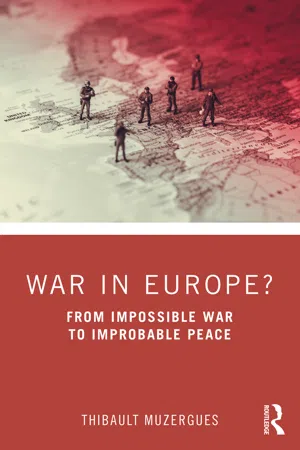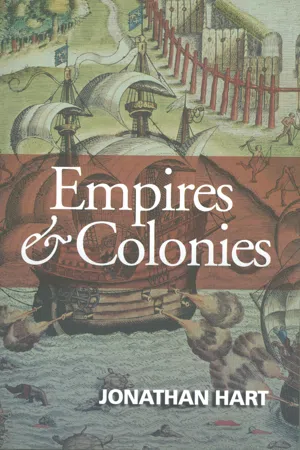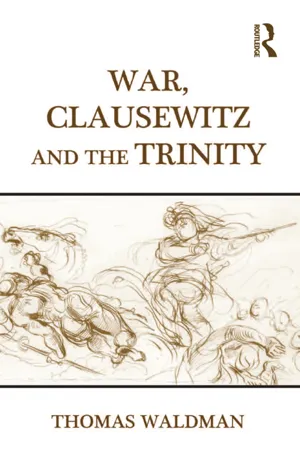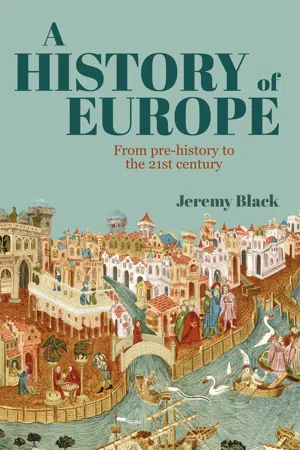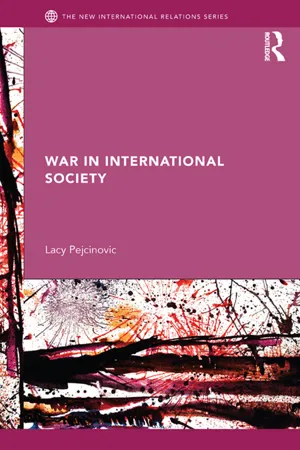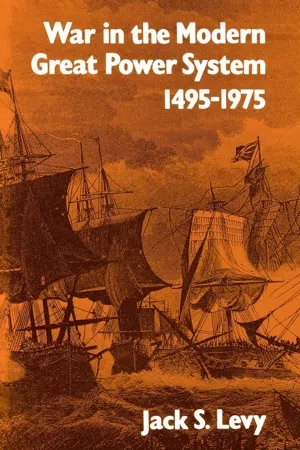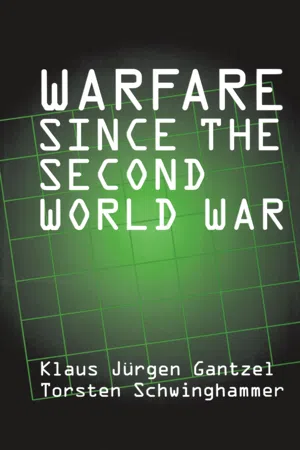History
European Wars
The European Wars refer to a series of conflicts that took place within Europe, involving various European powers and nations. These wars were often driven by territorial disputes, power struggles, and ideological differences, and they had significant impacts on the political, social, and economic landscape of Europe. The European Wars encompass a wide range of conflicts, including the Napoleonic Wars, the Thirty Years' War, and the World Wars.
Written by Perlego with AI-assistance
Related key terms
8 Key excerpts on "European Wars"
- eBook - ePub
War in Europe?
From Impossible War to Improbable Peace
- Thibault Muzergues(Author)
- 2022(Publication Date)
- Routledge(Publisher)
Whether looked at from a geographical or cultural perspective, Europe seems almost conditioned to be defined by its relationship with Mars. But if war is part of the continent’s DNA, this does not necessarily mean that Europe has to find itself in a permanent state of war, as the history of the past 75 years has shown. We will get back to this period in a moment, but it is worth examining the long history of the continent to understand the complexity of the relationship between Mars and Europe. Viewed over a long period of time, that relationship does look straightforward, and it is passionate. While it is true that there have been periods of peace in Europe for varying lengths of time, an overview of the continent’s long history shows that the peaceful times Europeans have been living constitute a remarkable exception in an otherwise very bellicose record.That European history may be principally punctuated by battles and armed conflicts should come as no surprise, for war has in fact defined the rise and fall of nations as much as the wellbeing and ruin of European communities and individuals. War has actually followed a pendulum movement between two opposite dynamics: one went toward unification (expansion of Rome, constitution of the Carolingian or Napoleonic Empire, etc.), the second toward atomization, which again presupposed more or less long and bloody conflicts.30 This double movement was almost perpetual in European history, in the sense that there were very few periods when the international or imperial system stabilized sufficiently to make war unnecessary. Moreover, an examination of these periods of Pax Europaea shows that when they did occur, they were geographically limited and fragile enough to guarantee the existence of armed conflict in one part of the continent even when the other was prosperous and peaceful – the 1990s come to mind here, as Europe found itself at peace and (at least in the West) prosperous while the Balkans disintegrated.If we are to take a look at the history of the relationship between war and Europe, our paths must first lead us to Greece before Rome. Greece is the true cradle of European civilization. The continent’s first cities developed there (although they were then more oriented toward the Mediterranean than toward the hinterland, unlike Egypt, for example31 ), and it is also in Greece, more precisely during the battles of Thermopylae and Salamis, that the first break between a Greek civilization based in Europe and the Near and Middle Eastern civilizations occurred. For the needs of the fight against Xerxes’s Persia, the Greeks had coalesced into an alliance to defend their homeland – but as soon as the threat disappeared, they took up their weapons again to fight among themselves and thus make sure that no power could take over the others. Athens’s attempt to build hegemony was checked by the declining power of Sparta. They locked themselves into 30 years of destructive warfare.32 - eBook - ePub
- Jonathan Hart(Author)
- 2014(Publication Date)
- Polity(Publisher)
6 European Civil War and World Conflict: 1914–1945Just when the expansion of empires and the acquisition of colonies were increasing, a cataclysmic war began, and the imperial order would shatter slowly and break down in the second half of the twentieth century. At the peak of power, the western European empires turned on themselves in a civil war that spread to a world conflict on a scale not seen before. It took another world war for the degree of change to sink in. In a generation, these empires were barely holding on, and in a generation after that they were remnants and memories. The United States and Soviet Union (which rose out of the Russian empire) would become, as de Toqueville had predicted, the great states of the world. The ambivalence and contradiction of the imperial theme played out in apparently irrevocable ways. But in January 1914, whatever premonitions the leaders of the empires had, they could not be sure that any of this would happen. Nothing was inevitable. In the human culture of politics and diplomacy, some massive failures were about to occur and a breakdown in civil society amongst the nations that considered themselves to be agents of civilization was about to happen. The arms race became armed conflict. In a kind of death wish, these European states brought one another down low and caused chaos and violence in Europe and in the world. Perhaps, given the level of violence in European expansion from the fifteenth century and the aggressive wars against indigenous peoples and amongst themselves, this European penchant for competitive wars and the seeking of the balance of power should not be surprising. None the less, hindsight was not available to the people in the period in question any more than it is available to us in our present circumstances. This is the irony of time and history. Perspective is something we seek, but we, like them, back into the future. - eBook - ePub
- Thomas Waldman(Author)
- 2016(Publication Date)
- Routledge(Publisher)
77 This was particularly true in France where the offensive spirit of Napoleonic warfare was emphasised even as technological change appeared to suggest the primacy of the defensive. Earlier, in Clausewitz's Prussia, memory of past successes under Frederick the Great was one reason out-dated methods were retained: in this way, sometimes history, as context, can retard adaptation to changing conditions.76 Hew Strachan, European Armies and the Conduct of War (Kings Lynn: Routledge, 2006).77 Gray, War, Peace and International Relations, p. 34.History weaves together political, social and cultural threads over time, and it represents a combination of traditions, experience and inherited beliefs. In particular, past wars may be considered the most potent aspects of history. If long, involving great sacrifices or marking important turning points in a group's history, they can powerfully shape attitudes and behaviour down the years (even ones fought hundreds of years ago, whether victory or defeat). For instance, the conflict in Kosovo between Serbs and Albanians during the 1990s was pervaded by the memory of the Serbian defeat in the 1389 Battle of Kosovo Polje. Tim Judah has even remarked that, in Kosovo, ‘history is war by other means’.78 In this way, history becomes inextricably intertwined with political realities today.78 Tim Judah, Kosovo: War and Revenge (New Haven: Yale University Press, 2000 ), pp. 1–32.Political context
This dimension encompasses a wide variety of elements, foremost amongst which are the nature of the political tensions between groups, the distribution of power in the system and the conditions and relationships within and beyond states leading up to and during war. Here we are concerned with prevailing power dynamics, be they local, domestic, regional or international. The political context is fundamentally characterised by continual change and is intertwined with other contexts such as economic power, technological sophistication or dominant values, all of which feed into power constellations surrounding and running through war. Morphing political conditions over time generate the immediate conditions which lead to conflict between groups and serve as basic determinants of war's character throughout and into the subsequent peace. As Gray notes, ‘The political context is the source of, and provides the meaning for, war and its conduct in warfare’.79 The political ‘womb in which war develops’80 - eBook - ePub
A History of Europe
From Pre-History to the 21st Century
- Jeremy Black(Author)
- 2021(Publication Date)
- Arcturus(Publisher)
Chapter 8
Europe at War
1914–45Europe was the epicentre of the two world wars. Vast numbers of soldiers died, as did millions of civilians, particularly in World War II. New political systems, such as fascism and communism, took hold, while society and culture changed dramatically.The Road to War
There was nothing inevitable about the route to war in 1914. Bellicosity and armaments had not led to war in recent years, even during the crises related to the Austrian annexation of Bosnia in 1908 and the Balkan Wars of 1912–13. However, in 1914 the alliance systems in place in Europe ceased to act as a deterrent to action. Instead, these alliances transmitted anxiety about shifts in international geopolitics and national politics. This was particularly true of Austro-Hungarian concern about the position in the Balkans. The assassination there, in Sarajevo, Bosnia, of the Archduke Franz Ferdinand, heir to Emperor Franz Josef, provoked the determination to punish Serbia in a misplaced attempt to produce stability in the multi-ethnic empire. This brought in Germany on Austria’s side, and Russia on Serbia’s.As alliances moved toward war, the Franco-Russian alliance led Germany to attack apparently more vulnerable France in order to weaken Russia and, in doing so, German forces advanced through neutral Belgium, which brought its guarantor Britain into the war. Far from ‘sleepwalking’ into a major conflict, all the powers understood that this would be a serious and costly struggle. However, none appreciated how major or how long.World War I
The terrible casualties of the conflict, about 9.45 million deaths, including about 2 million in Germany, 1.8 million in Russia, and 1.4 million in France, have contributed to a later perception that its heavy costs made it pointless. In fact, although at great cost, the aggressor powers were finally defeated and in a shorter period than many major wars before it. - eBook - ePub
Selling War
The Role of the Mass Media in Hostile Conflicts from World War I to the "War on Terror"
- Josef Seethaler, Josef Seethaler(Authors)
- 2013(Publication Date)
- Intellect Books(Publisher)
‘In modern times societies are increasingly integrated, in terms of communication, via the mass media’ (Buschmann, 2001: 102). The European Wars of the 1850s and 1860s gave the role of the mass press a sudden boost and placed newspapers at the center of public communication. By 1850 at the latest, politics recognized that the press was indispensable as an instrument of political mobilization (Buschmann, 2001: 113). Thus war became a fixed component of the contemporary world of the imagination – not only as a military event but also with respect to its political, social and historical contexts. Wars and crises were not only communicative events of the first rank but also screens on to which the clash of opinions between political world images and various social views were projected.In this chapter, I shall present four European examples between 1750 and 1918 in order to outline the techniques and forms in which the media reported on war. The Eighteenth Century – The Seven Years’ WarEven in the eighteenth century, current political news was disseminated most quickly and widely by the daily or weekly press. The development of this medium in the context of the seventeenth-century ‘communication revolution’ can, it seems, be attributed in part to the high proportion of war-related reportage in early newspapers and to the interest of urban elites in particular in this sort of information (for an overview, see Wilke, 2005). Events of the Thirty Years’ War, such as the storming of the city of Magdeburg, which was reduced to ashes in 1631, or the conclusion of peace in 1648, were early large-scale media events with a European dimension (Schultheiss-Heinz, 2004; Wrede, 2004; Blitz, 2001).This trend continued in the eighteenth century and was promoted by the evolving enlightened and critical public sphere. The Seven Years’ War, which was fought in a number of theaters of war in Europe and overseas between 1756 and 1763, was a major event. One of the leading German-language newspapers of the period, the Unpartheyischer Correspondent - eBook - ePub
- Lacy Pejcinovic(Author)
- 2013(Publication Date)
- Routledge(Publisher)
The international problem … was not war. It was hegemony, Louis’s version of the old drive for domination that had animated Charles V and the Spanish imperialists. It was the success of the system in solving that problem, via the operation of the balance of power that helps account for the absence of concern about the problem of war. No one in authority as a result of the recurring wars of the post-Westphalian system, believed yet that a new kind of thinking about war and peace was required. No one appealed for new attitudes or new institutions.Wars were prevalent in these intervening centuries, but it was not until the rise of Napoleon turned the French Revolution into a continental war and threatened the very existence of international society that a crisis in war as a fundamental institution can be seen. With these events came a process of re-defining why, when, and against whom war could be acceptably used. The eighteenth century is not neglected though. On the contrary, it plays an important role in understanding the institution of war, by way of the philosophical, political, and economic theories which developed over the century, as will be shown in both this chapter and Chapter 5 . There is a distinct sense of evolution in considerations of war, and in how international understandings of the identities of the members and non-members of international society, certain rights – that is entitlements as well as obligations and duties – and elements of necessity construct war as an institution. The unique features of war as an institution are established across the period of the nineteenth century as dynamic changes occurred across Europe and in the wider international system.The Napoleonic wars, the peace of Europe and the institution of warFigure 4.1 , is a French lithograph from 1869 by famed painter, sculptor, and political cartoonist Honore Daumier (1808–79). His work in the 1860s represented the deteriorating international situation, but also can be seen as a commentary on the turbulent decades from the end of the Napoleonic wars. Poor Old Fellow represents the internal political situation and the role of war in shaping the legitimate political identities giving rise to justifications for war in the early nineteenth century. The European equilibrium and balance of power in the nineteenth century is represented by a broken but still standing ancien regime military figure being propped up by bayonets. The uniform and weapons of war are symbolic of the connection between war and ancien regime - eBook - ePub
War in the Modern Great Power System
1495–1975
- Jack S. Levy(Author)
- 2021(Publication Date)
- The University Press of Kentucky(Publisher)
3
Definition and Identification of the Wars
In previous chapters I established the need for a systematic empirical study of war among the Great Powers over an extended temporal span and suggested that existing compilations of war data are not adequate for this purpose. The aim in this chapter is to define war and suggest operational criteria for the identification of all wars involving the Great Powers in the modern system. A detailed treatment of these criteria of inclusion and exclusion is necessary because in their absence no empirical study of war can be truly systematic. Problems involving the initiation and termination dates of war and the question of the aggregation or disaggregation of multiple wars are also examined. Because no study of this nature can be perfectly objective, it is necessary to acknowledge some of the biases inherent in these data-generation procedures.Definition of War
Before operational criteria for the identification of wars can be established it is necessary to define war conceptually. One of the most useful definitions is that suggested by Bronislow Malinowski: war is an “armed contest between two independent political units, by means of organized military force, in the pursuit of a tribal or national policy.”1 This definition avoids the serious problems that arise from legalistic definitions of war such as Wright’s.2 It recognizes that the essence of war is armed conflict involving the organized military forces of well-defined political entities. Malinowski’s definition, however, does not take into account a minimum threshold of conflict or violence as a prerequisite for war and hence fails to differentiate between wars and uses of force short of war such as border incidents or limited punitive strikes. In addition, the inclusion of the Clausewitzian concept of the pursuit of national policy, unless defined very broadly, would exclude conflicts initiated primarily for domestic political or even personal reasons. War must be defined independently of its motivations or other causes (or consequences), for otherwise hypotheses regarding the causes or consequences of war would be reduced to tautologies and made untestable. Therefore, this study defines war as a substantial armed conflict between the organized military forces of independent political units.3 - eBook - ePub
- Torsten Schwinghammer(Author)
- 2018(Publication Date)
- Routledge(Publisher)
For this reason our criteria for aggressor consists of who initiates the use of weaponry, rather than which side fires the first shot. Obviously there are instances where this cannot be determined. In cases where military action does not provide a clear indication of who attacked whom we assess from which side the decisive political direction toward war emanated. 9 2.3 Regional Categorization of Countries at War By regions we mean “world regions,” political-geographic areas which encompass a number of lands. We will make clear from the context if a “region” is used to indicate a local area within a land (e.g., southern Sudan) or an ethnographically or culturally demarcated area which can extend over the territory of several formal states (e.g., Kurdistan). In light of material and temporal differences in the process of global development it is important to determine regional differences concerning susceptibility to war. It is often difficult to demarcate the regions and allocate a particular land to this or the other region. Cartographers, physical and social geographers, historians, political scientists, and ethnologists, among others, address these issues from fundamentally different perspectives. We have approached our classifications practically, focusing primarily on areas of political conflict, interconnections, and comparisons. We differentiate the following regions as follows (Africa is substantially subdivided more than the other continents because of its relatively large number of states): 10 Europe (abbr. EUR), encompasses North, West, South, Southeast, Middle and Eastern Europe, the entire former Soviet Union and the present Russian Federation, the Baltic states, Belarus, Ukraine and Moldova
Index pages curate the most relevant extracts from our library of academic textbooks. They’ve been created using an in-house natural language model (NLM), each adding context and meaning to key research topics.
